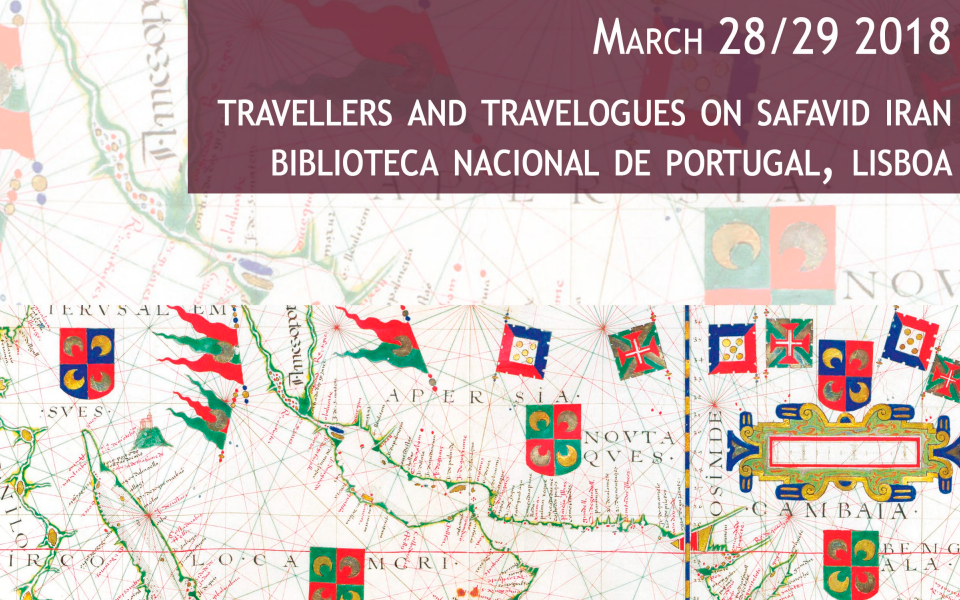
Program now available. Free admission subject to prior registration until March 15 2018 e-mail address: travelersafavid.cham@gmail.com
The beginning of the Safavid dynasty coincided with a renewed European interest on Iran, and thanks to an increasing number of printed narratives describing the voyages of western travellers both the country and its rulers became household names in Europe for the following two and a half centuries. Though Iran had been object of earlier travel writings by europeans since the Middle Age, the discovery of the printing press made these travelogues available to a larger audience, thus disseminatingmore information on the country, its history, people, religion and habits than ever before. However, not all travel writings are travelogues, and not all travelogues were published. As the travelogue became a literary genre in Renaissance and Baroque Europe, Iran come to be one of the countries traditionally depicted in these writings. This profusion of narratives, either manuscript or printed, testifies to the interest aroused by Safavid Iran among its contemporaries, and also bear witness to the fascination felt by travellers from different cultural backgrounds during their Iranian sojourn.
The rise of Safavids was contemporary with another event in Asian history, the arrival of European powers and their settlement in Asia in the sixteenth century, which meant that more people travelled through Iran than the Italian forerunners of the medieval period did. Starting with the Portuguese and continuing with the Dutch, the English, the French, and including the Poles and the Russians, a plethora of merchants, spies, diplomats, missionaries, pilgrims, globetrotters and many other europeans travelled over Safavid Iran. But there is also record of Asian travellers, namely from the neighbouring Ottoman Empire and Mughal India, whose writings provide other perspectives on Iran.
However, this is not cosmopolitanism, despite the cosmopolite outlook of the travellers and their writings. The outcome of the voyage through Safavid Iran differed according to the place of origin, time and education of the voyager, but most writings strengthen the country’s individuality and uniqueness. More than ideas, what travelled to Europe was a diversified set of informations about its Shia present, but also the Classical and biblical past of a country traditionally called Persia, whose cultural irradiation was felt in bordering Islamic states and not in the West. The emerging image of Safavid Iran in these travel writings was never one sided, it was complex, though some stereotypes appeared to appeal for the taste of the exotic among its European readers. Religion may have worked as the main filter of alterity, but in time Iranian otherness was established in other comparative categories in the western travel writings. Words and iconography (prints, drawings, paintings) ended up by forming a more complete image of Iran, which left an enduring impression in European minds and imagination.
The International conference «Travellers and travelogues on Safavid Iran» aims to discuss:
a)travel writing genre, either travelogues or any other writing form where the travel impressions of the people travelling through Iran is recorded directly or indirectly;
b)travellers and their travelogues (itineraries and writings in the context of its time);
c)travellers (who were they, and why did they travel to Iran);
d)cultural transfers and debates around travel writings.
Sponsors: Biblioteca Nacional de Portugal; Soudavar Memorial Foundation; Consejo Ibero-Safavid de Estudios Históricos; Fundação Millennium bcp; Fundação Luso-Americana para o Desenvolvimento
Collaboration: EUROEST: Proyecto de Excelencia 2016-2019 «La otra Europa: individuos y grupos de la Europa oriental y del Imperio Safaví en España y la América Española de la Edad Moderna», HAR2015-64574-C2-1-P e C2-2-P (MINECO/ FEDER)
Scientific Committee
Ana Paula Avelar (CHAM)João Teles e Cunha (CHAM)
José Cutillas Ferrer (UA)
Rui Manuel Loureiro (CHAM)
Organization
CHAM / NOVA FCSH
Soudavar
Call for Papers(.pdf)
Poster(.pdf)
Programme(.pdf)
For more information(Web)
Abstracts(Web)
Vídeo | CHAM’s Youtube Channel(Web)







